Toshiba Satellite M645: The Steady March of Progress
by Dustin Sklavos on April 29, 2011 12:50 AM ESTMainstream Performance
While Jarred has already gotten his mitts on a couple of dual-core Sandy Bridge notebooks, this is my first experience with the new architecture in this form. From the numbers I pulled testing the Toshiba M645, it looks like the old, perennially-underpowered quad-core i7-720QM workhorse may finally be put out to pasture. It's still somewhat faster than the 2410M in multi-threaded workloads, but it loses everywhere else.
We've highlighted three other systems for comparison in this round. In black we have the Dell XPS 15 L502x, sporting a quad-core i7-2630QM and GT 540M graphics. Last year's XPS 15 L501x with i5-460M and GT 420M is in red, and finally we have the i5-2520M with HD 3000 showing what you can get from dual-core Sandy Bridge without a discrete GPU.
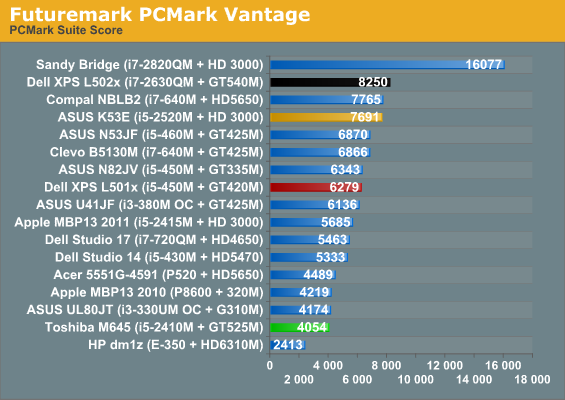
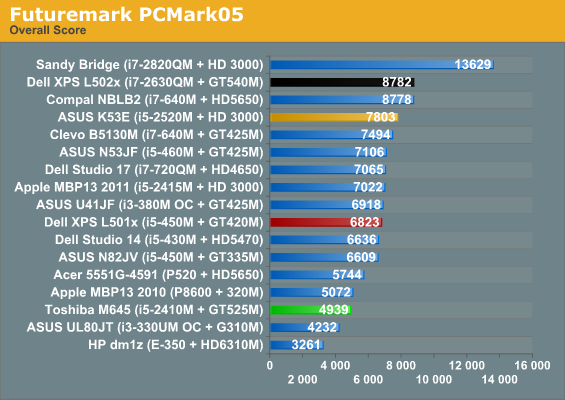

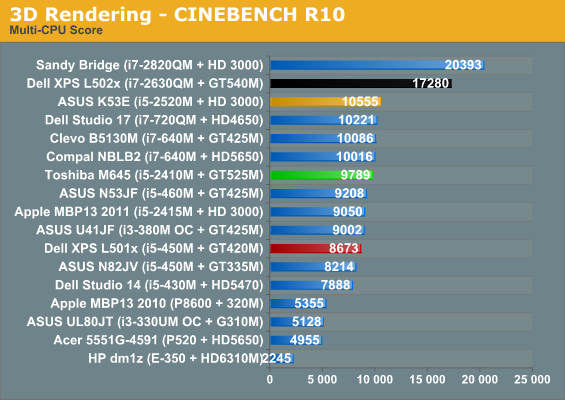
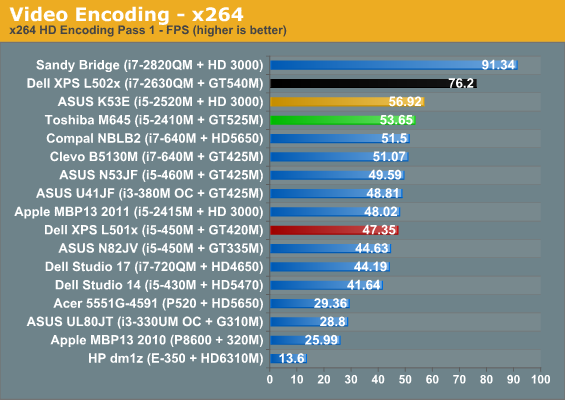
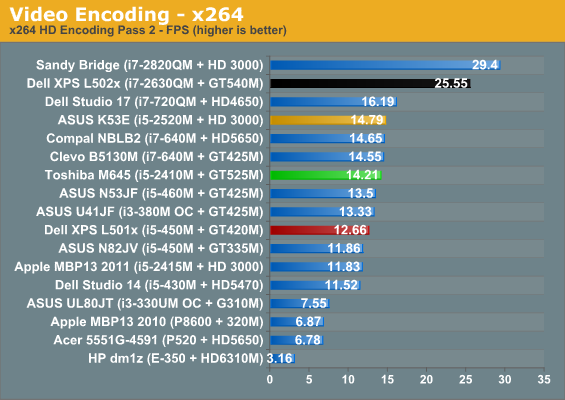
PCMark is unkind to the M645, but it tends to skew heavily towards faster storage subsystems and the 5400RPM Toshiba hard drive is among the slowest. When we get to more CPU-limited workloads like Cinebench and x264 encoding, the i5-2410M is allowed to stretch its legs and the M645 surges forward to near the top of the heap, producing performance virtually on par with last generation's top end mobile dual-core chip. The i7-640M threatened the i7-720QM with early obsolescence, and the middle-of-the-road i5-2410M only helps make good on that threat. Such is progress.
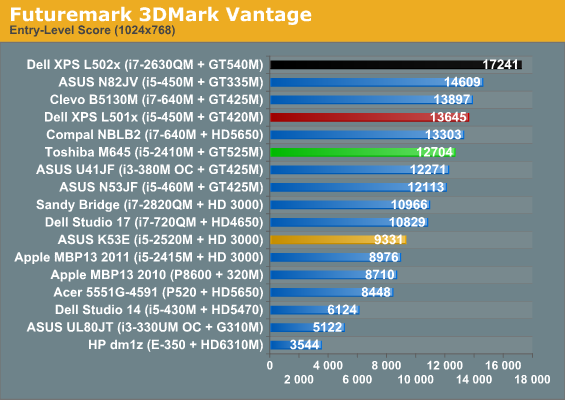
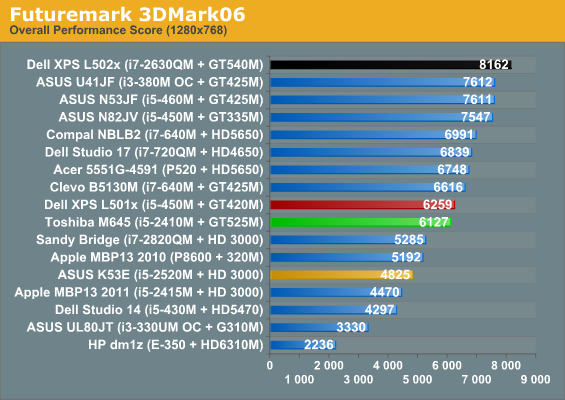
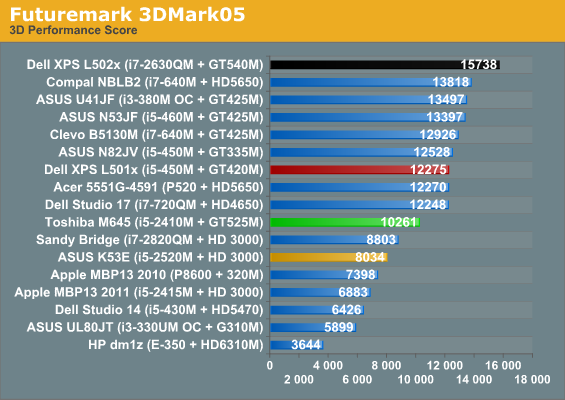

Unfortunately 3DMark is far less kind and it's here where we first see just how much damage the low clocks on the GeForce GT 525M have done. While the 96-core GPU is still a notable improvement over Intel's integrated graphics, it has a hard time hanging with even "last generation's" bottom rung 96-core chips (though in defense of "last generation," the 500M series is basically just 400M chips with a speed bump.) When we get to gaming performance, you'll see how brutally performance has been curtailed.










34 Comments
View All Comments
Icabus - Friday, April 29, 2011 - link
I don't know if I speak for everyone, but I would love to see 2 additional graphs. On the performance page a graph showing the current price, or price range for the other comparable offerings would be nice so you could see what kind of performance increase you are getting for the increase in price. I know this would not be easy as the price can very across the internet, and I understand price can change with rebates and sales all the time.The other graph is a little easier, but on the power usage page I would love to see the weight here. Since the different offerings come with different size batteries, it would be nice to see just how much of a difference there is between to offerings when on has a 4xWHr battery and another has a 8xWHr battery.
Chris Peredun - Friday, April 29, 2011 - link
"NVIDIA specifies the 525M to run the core at 600MHz (and thus the 96 CUDA cores at 1.2GHz), but Toshiba has substantially reduced its core clock to just 475MHz (reducing the CUDA cores to a paltry 950MHz). The cut is a brutal one that you'll see reduces performance below even a GeForce GT 420M."Thanks for highlighting this issue on page 1, Dustin.
In a dream world, NVIDIA would come kick them in the groin and tell them not to label or refer to the GPU in this unit as a "GT 525M" when it is *not obeying specs.*
Is there a particular reason we can't have that dream come true? I'm sure there's some country where a "false advertising" suit would land a hit.
Pessimism - Friday, April 29, 2011 - link
I'd love to see a "durability roundup" in which you take all the $699 budget wonder notebooks and put them through a series of impacts, drops, and spills followed by a photographed teardown detailing internal damage to see how these mass produced plastic consumer notebooks stand up to abuse.TegiriNenashi - Friday, April 29, 2011 - link
With processors, memory and the other stuff stagnated these days perhaps it makes sense for vendors to differentiate on their screen offering. Is it hard to comprehend how many users can't stand 16:9?jah1subs - Friday, April 29, 2011 - link
You can complain all you want about 16:9 and it will make absolutely no difference. Several years ago, I noticed a story on digitimes.com that said panel manufacturers realized that they could lay out more 16:9 panels than 16:10 panels in later generation manufacturing plants, perhaps 6th generation. The difference was 5% or 10%I have a question. For those who have seen 14" or 15.6" panels, is 1600x900 more or less readable than 1366x768, all other things being equal (ceteris paribus)?
P.S. ceteris paribus is correctly spelled. I searched it before posting the message.
kmmatney - Friday, April 29, 2011 - link
"I have a question. For those who have seen 14" or 15.6" panels, is 1600x900 more or less readable than 1366x768, all other things being equal (ceteris paribus)?"The answer is: 16:9 sucks
AnnonymousCoward - Saturday, April 30, 2011 - link
Readable? Bigger will always be more readable! The trade off is workspace.btw, the poster didn't even "complain" about 16:9. But I will: it sucks :) And if 1 manufacturer still offered 15.4" 1680x1050 or 14.1" 1400x1050, it would be a huge differentiator and there's a good chance they'd get my business. Make it IPS, too. I'll happily pay the premium.
Letros - Friday, April 29, 2011 - link
Hey guys, long time reader first time poster, great site BTW =)I have a similar model of this laptop, the customized M640, didn't care for the Blu-ray player on the retail model, so I saved a few bucks, while opting for a back-lit keyboard, 7200 HDD, and extended cell battery, came out to $920.
Anyway, I was pretty upset myself when I saw the GT525M at 475 Mhz, however Nvidia System Tools lets you bring the clock back up, I actually have it overclocked at 630/950, up from the 525M spec sheet of 600/900. My GPU temps don't get above 80 C and the laptop does a good job at cooling(had it running for a few hours to confirm stability). My 3dMark 06 was 7600 marks. I don't play too many games on it though, have a desktop for that, but it's nice for some mobile SC2.
I'm satisfied with my purchase, even with the BS clock reduction, a higher res screen would have been nice...
TrackSmart - Friday, April 29, 2011 - link
Good to know that the clock speed is easily modified and that it stays within reasonable temperature limits (for a GPU running at full tilt in a laptop). I don't do any mobile gaming, so I opted for the Portege series (only 3.2 lbs). I also lament the low resolution, low quality displays that Toshiba uses, but I couldn't find any alternatives in the same price range and weight.Beenthere - Friday, April 29, 2011 - link
I'm not gonna buy any InHell product after their criminal convictions.